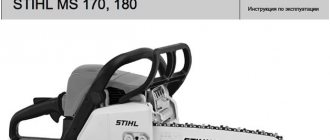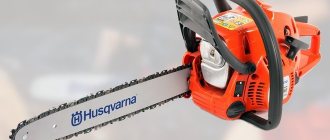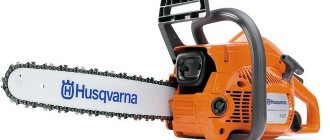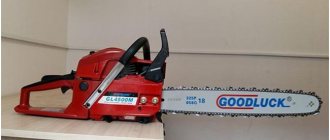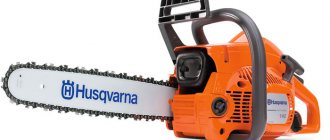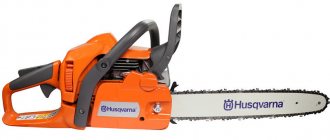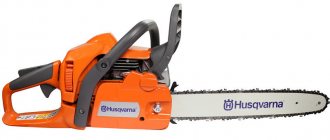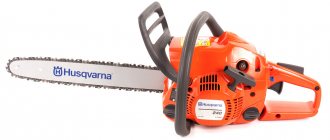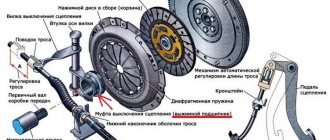A chainsaw is a motorized tool that is characterized by the presence of a two-stroke internal combustion engine. Moreover, modern models of saws do not run on pure gasoline, but on a special gasoline-oil mixture (95 gasoline and oil are mixed in a ratio of 1 to 50).
Sawing with such a tool is not too difficult, especially if you get the hang of it. But we must not forget that the chainsaw itself is considered a source of increased danger. Therefore, when holding it in your hands, you should be vigilant.
Basic safety rules
How to use a chainsaw of a particular model is not written anywhere better and more accurately than in the corresponding instructions from the manufacturer (and instructions always accompany such products).
A detailed study of it will clearly not be a waste of time. The main components of the instrument, features of startup and maintenance, and safety precautions are indicated there.
On the other hand, there are general rules for working with a chainsaw and safety principles that must be followed regardless of the brand of the tool and the experience of the master.
Equipment
Even if you only need to cut a few logs into firewood for the stove, it is worth wearing protective equipment. The head must be wearing a helmet with a face mask and headphones. Gloves made of hard material are put on your hands.
When felling trees, wear a brightly colored jacket made of durable fabric and cut-resistant pants. Of course, more requirements are placed on the equipment of a professional feller than on the clothing of an ordinary person. But in any case, it should be comfortable, wear-resistant, breathable, and should not hinder movement during work.
It is advisable to wear boots or other closed, comfortable and durable shoes on your feet. The lower part of the trouser legs should not flutter in the wind. For professionals, they produce special boots with steel plates that protect the lower leg from possible cuts.
Tips and tricks
To ensure that there are no problems with the chainsaw and that it works without breakdowns, you should follow the operating rules:
- Compliance with safety rules.
- Run-in after purchase.
- Check chip thickness regularly. If it’s small, then you need to sharpen the chain. If the chain is sharp, then the chip thickness is approximately 3-4 mm.
- Do not cut with the end of the tire.
- It is advisable to use replacement parts from the same manufacturer as the saw model.
- If you are new to working with a saw, then practice on models with low speeds.
Key Operating Principles
The chainsaw is always held with both hands, tightly gripping the handle with all fingers (the thumb of the left hand should be located under the front handle). The saw should be placed closer to the body - this way the arm muscles will tire less (there is no need to be afraid of the proximity of the saw). In addition, in this position it will be easier to maintain balance and maintain full control over the process.
Your legs should be spread wide, with your knees bent for stability, but your back should be kept straight. If the mechanic needs to change position, he must first turn off the engine by activating the brake. If you need to move the chainsaw over a considerable distance, it is recommended to cover the tire with a casing.
It is better to learn to use a chainsaw on horizontal, not too thick logs at first. Once you feel confident and strong in your hands, you can learn to fell trees. To cut logs or beams straight, you need to make marks with a pencil and then gradually move along these marks. It’s good if you have the opportunity to watch how experienced sawyers work.
Preparation stage
Before cutting down a tree, you should make sure that surrounding objects (railway rails, buildings, power lines, highways, etc.) will not be damaged as a result of the falling trunk. There should be nothing unnecessary within a distance of two lengths of the tree being cut in any direction. In addition, if the place is crowded, then it is necessary to use warning signs - this is a must.
Pay attention to the following points:
- whether the tree grows straight or not;
- is there a slope of the soil;
- what is the strength of the wind and in which direction does it blow.
This ultimately determines in which direction the trunk will fall. You need to be especially careful with rotten, dry wood. It may behave unpredictably for the lumberjack and may not fall as planned. A damaged tree can be identified by external signs (dry branches, damaged trunk). Experienced fellers determine the quality of wood by tapping the trunk - a healthy tree “rings”, while a sick tree sounds dull or inaudible.
The ground around the tree must be cleared of bushes and other growth - this is another important preparatory action. It is necessary to remove everything that could impede the safe movement of the master with the chainsaw during the felling process.
How to saw
The sawing procedure itself usually goes like this. The lumberjack stands to the right of the trunk and makes a guide cut on the natural slope side at a 45-degree angle to a depth equal to about a quarter of the tree's diameter. This undercut should be as low as possible - this will make it easier to fell the trunk (and the stump will not be too high). It is also worth keeping in mind that the undercut seems to indicate in which direction the tree will subsequently fall to the ground.
A horizontal cut is then made on the opposite side of the tree—the main felling cut. There should be some small distance between it and the inclined undercut - this gap is needed so that the tree does not collapse prematurely.
Note! To prevent the tire of a power tool from being clamped in the main cut, a wedge is inserted into it.
During the work, it is necessary to monitor where the trunk is tilting in order to have time to react if something goes wrong. When the tree begins to fall, you need to quickly remove the chainsaw from the cut, turn off the engine and leave the dangerous place.
If, having caught on another trunk during felling, the tree does not fall completely, then professional help will be required. Leaving it unattended, as well as trying to correct the situation on your own, is prohibited.
There are times when a chainsaw bar gets stuck in the trunk. There is no need to panic and suddenly pull it out, especially if the tool is in working condition. First of all, you need to stop the engine. And then you should manually tilt the barrel little by little until the chainsaw slips out.
What can beginner carving masters do?
If you want to try your hand at wood carving with a chainsaw, then first you should choose a simple shape, for example, you can cut out a mushroom or a cube.
So, first you need to make a blank from wood with a chainsaw, that is, give the product a general outline. At this stage, special precision is not needed
It’s just important not to remove too much. Keep a drawing of the object or a sample in front of you to more accurately represent the proportions of the finished sculpture
Next, you will have to master the skills of carving the end of a tire. In this case, the chain must be well (correctly) tensioned, otherwise strong vibration will bother you.
Finished wooden sculptures are sanded with sandpaper and covered with a protective layer, paint or varnish. As you acquire skills, you can begin making more complex figures. Crafts made from logs, namely pillars depicting people or animals, are very popular among chainsaw carvers. They are installed vertically (buried in the ground). The photo below shows the process of making a simple figure of a bear from a log, which is suitable for beginner carvingists.
To create birds, more experience and dexterity are required, since very small details of the sculpture (head, feathers, etc.) must be processed.
How to cut down a thick tree
To cut down large and thick trees, you will need to use special equipment. And in general, cutting such trees is very difficult - this is not a task for beginners, but for professionals with serious experience. Loggers approach each thick tree individually, and the choice of the optimal technology depends on many factors.
One possible solution is to cut down the trees piece by piece with a chainsaw. And here, loggers first have to work at high altitudes using climbing equipment.
Another method is to fell the entire tree with the trunk stretched in the desired direction. In this case, a cable is used, which is fixed to the trunk at a height of about 5.5 m, after which a wedge is made in the trunk from the side of the planned fall with a chainsaw. Then the cable (using a winch, tractor or car) begins to be slowly pulled. At the same time, the feller trims the trunk on the side opposite to the cut wedge. If the length of the tire is not enough, then another cut is made at a height of about 30 cm from the previous one. It is important that the lumberjack manages to bury the tire a significant distance and the tree begins to fall in the right direction.
Three device classes
Currently, on the Russian market you can find a large number of chainsaws, which can be divided into three classes:
- The first class includes simple household devices that are designed for simple home needs. Most often, such chainsaws have little power, but they cope with all their responsibilities very well. Using such a chainsaw, you can cut down rotten wood or prepare firewood for a bathhouse. Despite the fact that the functionality of such saws is minimal, this is easily compensated for by ergonomic controls and their low weight.
- The second class includes the so-called semi-professional models, which are capable of performing almost any work - from repair and construction tasks to felling trees. But at the same time, such models have one significant drawback - they are not designed to work 8-10 hours a day. It is for this reason that they are called semi-professional. Most often, loggers use such saws as loppers.
- The third class includes professional saws, which are an excellent solution for people who specialize in deforestation. Such devices can be used for 10-15 hours a day, allowing you to work without a break for 8-10 hours.
How to cut down branches correctly
The branches are cut down after the tree has fallen. And this process also requires extreme composure. There is a high probability of kickback here, and therefore it is recommended not to use (or use as little as possible) the nose part of the tool.
Note! According to statistics, loggers receive most injuries when they are cutting branches.
The chainsaw can be leaned against your hip or against a tree - these are the optimal positions. First of all, you need to work with the branches that, when the tree was still standing, were closest to the ground. And in the upper part of the trunk, it is more convenient to cut branches by turning the chainsaw on its side. As for thick branches, it is permissible to cut them down in parts.
What problems might arise?
Many people wonder why a chainsaw cuts crookedly or falls on its side? This occurs due to the fact that the chain tension has weakened or the teeth have been ground down. It can also cut crookedly due to uneven sharpening. Therefore, all manufacturers strongly recommend carrying out a technical inspection before each use of the tool.
Users are also interested in the question, why does the saw move to the side? This happens due to uneven sharpening of the links. It is advisable to carry out sharpening in specialized service centers. Another reason may be that the saw set does not match the saw model.
Sawing into logs
Working with an already lying trunk and cutting firewood with a powerful chainsaw is much easier than felling a tree. However, here you can encounter problems - the tire may get stuck in the trunk, and in order to pull it out, you will have to use a jack.
It is better to saw the trunk from the top, gradually moving towards the root. The lumberjack's task in this case is to cut the trunk into several large logs that can be rolled. The cut can be either upper or lower. The top cut is performed until the barrel begins to lower and compress the tire. After this, if possible, it is necessary to finish the trunk from below. If it is not possible to get close from below, then next to the first upper cut several more are made until the work brings results. The sawing of individual parts of the trunk into logs is also carried out from above, that is, with the top cut.
Longitudinal sawing of logs
Before cutting the logs, the optimal method is chosen, which depends on the size of the required lumber, the desired surface quality of the boards, the type of wood and technical capabilities.
They start cutting only after inspecting the log, after which it is freed from bark and branches. If there are no flaws on the log, then processing is faster, and the lumber is of higher quality.
Cut the logs
Depending on the orientation of the growth rings, different types of log cutting are used:
- Radial view - the cut passes along the radius of the growth rings. They obtain high quality lumber that does not deform.
- Tangential view - the log is sawn tangentially to the growth rings. The lumber is of low strength.
- Parallel view - the cut runs parallel to the grain of the wood.
For sawing in the direction of the grain, the simplest method is a circular cut. First of all, the croaker is cut off. After this, the log is turned 180 degrees, and then the second slab is cut off. To obtain boards, the log is constantly turned.
For high-quality sawing of logs in different ways, the following general rules are used:
so that the log does not move during processing, it is securely fixed; if sawing is done with a chainsaw, then use a chain for longitudinal processing
In order for the cut to be smooth and the saw not to be pulled to the side, the chain must be well sharpened and not sag; for sawing by hand, they try to select logs of short length; before sawing, the log is marked for a certain type of cut; sawing logs into boards begins with cutting the slab; special attention is paid to safety measures at all stages of sawing logs. Sawing of logs is carried out on their own using various cutting tools
Sawing logs is done on your own using various cutting tools.
Electric or gasoline saws
A gasoline saw has advantages over an electric model:
- the workplace is not connected to a power source;
- higher power;
- thanks to soft start and speed control, the risk of saw chain breakage is reduced;
- continuous operation for up to an hour, there is no need to interrupt the cut to allow the saw to cool down;
- You can work in any humidity, for example during rain.
Mini disc sawmill
One or two disks separated by an insert are used as a cutting element.
This sawing machine is widely used because of its advantages:
- simple design, equipped with an electric or gasoline engine;
- easy to use;
- accuracy of cutting logs according to marks;
- high productivity when sawing logs.
The main requirement for a circular saw is a durable frame and a powerful engine.
The peculiarity of independent longitudinal cutting of a log is clearly visible in four simple methods.
Starting a chainsaw
Before the starting procedure, you should first fill the appropriate compartments with fuel mixture and metal chain lubricant. Check the chain tension and tighten it if necessary. After this, you need to place the chainsaw on a flat, stable surface, at some distance from the refueling site (for fire safety purposes). Next, take the front handle with your left hand and place your right foot on the back.
Then you need to press the ignition button, pull out the throttle and pull the starter handle several times. When the chainsaw engine emits a flash, the throttle valve is pushed back, and the starter handle, on the contrary, is pulled outward to the maximum. This movement must be repeated until the engine starts.
The next step: you need to turn off the chain brake and press the gas several times so that the chainsaw warms up. The technician should also check the lubrication supply to the chain. To do this, the saw must be brought to a clean sheet of paper. The appearance of an oil stain on the sheet will mean that everything is in order and there is enough lubricant.
If the chainsaw has already worked for a certain time and was simply turned off, then it is started according to a simplified algorithm - that is, only the starter handle is used, and there is no need to touch the throttle valve.
Walking saw
Mandatory procedure before using sawing work. This is done so that the engine parts start. The switching process itself consists of the following elements:
- Preparation of the mixture. To do this, mix oil and gasoline in the proportions specified in the instructions. It is advisable to use high-quality materials, since inexpensive analogues will quickly damage the engine.
- Pour oil into the chain oil tank. It's easy to check availability. Place the saw on a white piece of paper and briefly turn on the saw. If oil stains appear on the sheet, the lubrication system is working.
- Start the saw and operate it without load.
Tree felling tools
In order to fell a tree in a certain direction, professional fellers and others use special tools. The most common of them are felling forks, wedges and blades. Special hydraulic or mechanical jacks can also be used.
Wedges can be made from wood directly at the felling site or purchased in specialized stores. Wedges made of polymer materials are widely used, the size of which is selected depending on the diameter of the tree being cut.
In order to have an idea about felling jacks, we recommend watching a video that shows how, using this device, a lumberjack cuts down and lays a pine tree in the direction he needs.
Felling blades work on the principle of a wedge, only they have a lever, thanks to which the operator can increase the force and help the tree fall in the desired direction. The principle of operation of the felling blade or also called the lever can be found out by watching the video below.

